The Taipei City Government yesterday broke ground for the second phase of the Yongchunpi Wetland Park (永春陂生態濕地公園) in the city’s Hsinyi District (信義) in a bid to increase biodiversity and improve the Sishou Mountain trail.
The park, the former Yongchunpi military camp owned by the Ministry of National Defense, was transferred to the city government after sitting idle for 10 years.
The city originally planned to build more than 2,000 public housing units on the 3.43 hectare plot, but after collecting suggestions from experts, Taipei Mayor Ko Wen-je (柯文哲) in July 2015 announced that the nation’s first urban wetland park would be established on the plot.
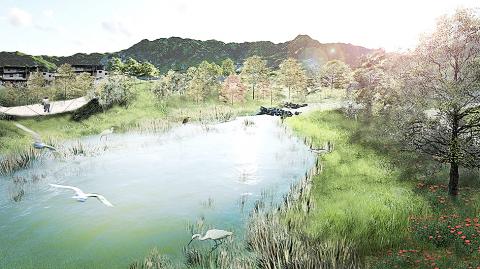
Photo: CNA
The first phase of the park’s construction was completed and it was opened to the public in September last year. It includes two ecological ponds, an ecological trail, two observation platforms and an observation classroom.
At yesterday’s groundbreaking ceremony, Ko said the city government bought the plot for about about NT$600 million (US$19.73 million) and spent about NT$4 million on the first phase, adding that it plans to spend about NT$68 million on the second phase.
The park would cover 3.98 hectares when completed and would be incorporated into the Sishou Mountain ecosystem, also serving as a flood detention pond, he said.
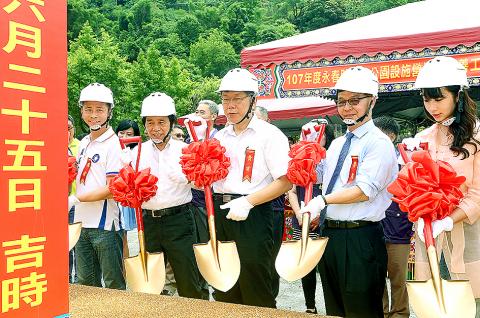
Ko said the wetland would reduce the city’s urban heat island effect — which means the metropolitan area is much warmer than surrounding rural areas — and improve the surrounding environment.
The park would provide diverse habitats for plants and animals; increase water holding capacity by 4,895m3 and detention pond storage volume by 1,207m3; and is estimated to absorb about 57 tonnes of carbon dioxide annually, the Taipei Public Works Department’s Geotechnical Engineering Office said.
Ko said a borough warden told him that many visitors come to the Sishou Mountain trail, adding that he has instructed Taipei Department of Public Works Commissioner Pong Cheng-sheng (彭振聲) to make a comprehensive plan to integrate the park, the trail and the nearby public restrooms to improve the experience of visitors.
The park is expected to be completed by October next year, the office said.
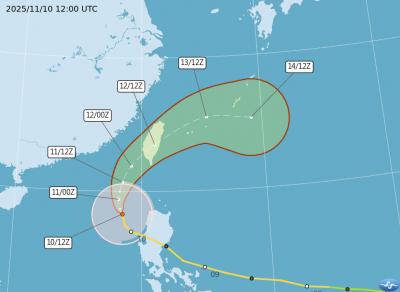
The Central Weather Administration (CWA) today issued a sea warning for Typhoon Fung-wong effective from 5:30pm, while local governments canceled school and work for tomorrow. A land warning is expected to be issued tomorrow morning before it is expected to make landfall on Wednesday, the agency said. Taoyuan, and well as Yilan, Hualien and Penghu counties canceled work and school for tomorrow, as well as mountainous district of Taipei and New Taipei City. For updated information on closures, please visit the Directorate-General of Personnel Administration Web site. As of 5pm today, Fung-wong was about 490km south-southwest of Oluanpi (鵝鑾鼻), Taiwan's southernmost point.
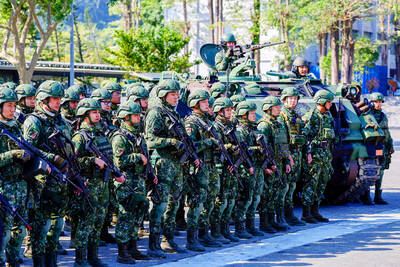
Almost a quarter of volunteer soldiers who signed up from 2021 to last year have sought early discharge, the Legislative Yuan’s Budget Center said in a report. The report said that 12,884 of 52,674 people who volunteered in the period had sought an early exit from the military, returning NT$895.96 million (US$28.86 million) to the government. In 2021, there was a 105.34 percent rise in the volunteer recruitment rate, but the number has steadily declined since then, missing recruitment targets, the Chinese-language United Daily News said, citing the report. In 2021, only 521 volunteers dropped out of the military, the report said, citing
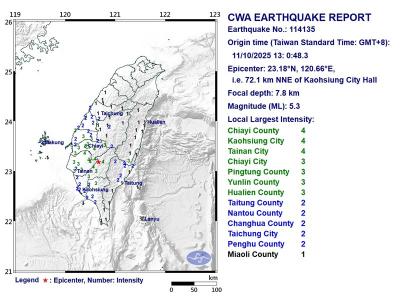
A magnitude 5.3 earthquake struck Kaohsiung at 1pm today, the Central Weather Administration said. The epicenter was in Jiasian District (甲仙), 72.1km north-northeast of Kaohsiung City Hall, at a depth of 7.8km, agency data showed. There were no immediate reports of damage. The earthquake's intensity, which gauges the actual effects of a temblor, was highest in Kaohsiung and Tainan, where it measured a 4 on Taiwan's seven-tier intensity scale. It also measured a 3 in parts of Chiayi City, as well as Pingtung, Yunlin and Hualien counties, data showed.

Nearly 5 million people have signed up to receive the government’s NT$10,000 (US$322) universal cash handout since registration opened on Wednesday last week, with deposits expected to begin tomorrow, the Ministry of Finance said yesterday. After a staggered sign-up last week — based on the final digit of the applicant’s national ID or Alien Resident Certificate number — online registration is open to all eligible Taiwanese nationals, foreign permanent residents and spouses of Taiwanese nationals. Banks are expected to start issuing deposits from 6pm today, the ministry said. Those who completed registration by yesterday are expected to receive their NT$10,000 tomorrow, National Treasury